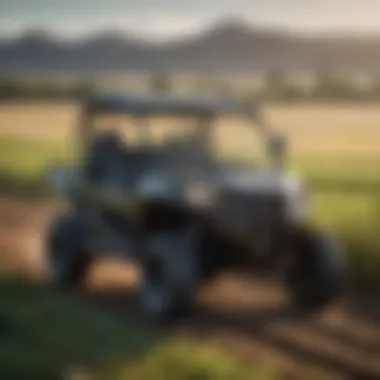The UTV Pioneer: Transforming Agricultural Practices


Intro
The integration of Utility Task Vehicles (UTVs) in the agricultural landscape represents a significant advancement for farming practices. Every day, farmers and agricultural workers face emerging challenges, from efficiency and productivity to environmental sustainability. UTVs, with their robust capabilities and versatile designs, are proving to be an essential tool in addressing these issues. This article aims to delve into the multifaceted role of UTVs in shaping modern agriculture, analyzing their features, benefits, and the challenges they present.
Key Concepts and Terminology
Basic Definitions
Utility Task Vehicles, or UTVs, are four-wheeled vehicles designed for off-road conditions. They are utilitarian in design and often feature a cargo bed for transporting goods and tools. Unlike traditional tractors, UTVs can maneuver through diverse terrains with greater ease and typically offer seating for multiple passengers. Their power and versatility make them suitable for a wide range of agricultural tasks.
Historical Context
The concept of UTVs emerged in the late 20th century, evolving from older all-terrain vehicle (ATV) models. As agriculture began to embrace mechanization, UTVs filled a niche for tasks requiring both transport and cargo capabilities without the size and complexity of tractors. Since their introduction, UTVs have undergone significant improvements in terms of performance, safety, and comfort, aligning them further with the needs of today's farmers.
Recent Innovations and Trends
Technological Advancements
Recent innovations in UTV technology include enhanced engine performance, improved fuel efficiency, and the incorporation of advanced electronic systems. Some models now feature autonomous capabilities, allowing for automated operations in tasks like planting or fertilizing. Additionally, GPS technology is enabling precision agriculture by assisting farmers in optimizing field operations.
Sustainable Practices
Sustainability is a key focus of modern agriculture, and UTVs are adapting to this need. Manufacturers are increasingly designing vehicles that can run on alternative fuels or have hybrid powertrains to reduce carbon footprints. Furthermore, the durability of UTVs promotes sustainable practices by allowing equipment to last longer and reducing the need for frequent replacements.
Practical Applications and Techniques
Step-by-step Guides
- Selecting the Right UTV
- Utilizing Attachments
- Regular Maintenance
- Consider your specific needs and the types of tasks you will perform.
- Look for models that offer the necessary power, capacity, and features.
- Many UTVs can be equipped with various attachments, such as sprayers, plow blades, or cargo boxes.
- This versatility can greatly enhance productivity for specific tasks.
- Ensure routine checks on engine performance, tire pressure, and fluid levels.
- Regular maintenance prolongs the vehicle's lifespan and optimizes its performance.
Case Studies
- A farm in Central California implemented UTVs primarily for transporting harvests. As a result, they reported a 30% increase in efficiency thanks to the quick transport between fields and storage areas.
- Another example can be seen in a vineyard in Oregon that uses UTVs with attached sprayers to manage pest control efficiently. This practice allows for targeted application, reducing chemical usage and ensuring safer practices for the environment.
The rising trend of UTV adoption among farmers is not just about efficiency; it symbolizes a broader shift towards integrating technology and sustainability into agriculture.
As we move towards exploring more on the implications and future developments tied to UTVs, it becomes clear that these vehicles are much more than tools; they represent a paradigm shift in how agricultural workers approach their responsibilities.
Prelims to UTVs in Agriculture
The integration of Utility Task Vehicles (UTVs) into agriculture marks a significant shift in modern farming practices. UTVs offer a blend of versatility, power, and functionality that caters specifically to the unique demands of agricultural work. They are not merely tools; they represent a transformation in how farmers approach their daily tasks.
In this context, it is important to understand that UTVs serve various purposes on a farm. Their design supports tasks like transporting supplies, equipment, and personnel across rugged terrains. Moreover, their compact size and robust build allow for efficient maneuverability in tight spaces, making them ideal for a range of applications.
Moreover, embracing UTV technology can lead to substantial efficiency gains. Alongside traditional farming equipment, UTVs optimize operational workflows, meaning tasks can be completed in less time. The resulting increased productivity is a crucial factor that farmers and agronomists must consider when looking to modernize their operations.
In horticulture, enhanced mobility and the ability to carry out multiple duties make UTVs valuable assets. From field maintenance to crop monitoring, the multifunctionality of UTVs supports the evolving needs of agriculture today.
A further consideration detailed in this article will be the evolution of UTV technology itself. Understanding how these vehicles have developed can inform the choices of farmers. Identifying the latest innovations assures them they are investing in the right solutions.
UTVs symbolize a commitment to enhancing agricultural efficiency, aligning with sustainability goals that prioritize environmental stewardship and operational sustainability.
As we explore the definition and purpose of UTVs and the technology advancements that have shaped this remarkable tool, the narrative will unfold to reveal the true impact these vehicles have in transforming agricultural practices.


Key Features of UTVs
Utility Task Vehicles (UTVs) have become essential in modern agriculture. They provide unique features that enhance efficiency and productivity. Understanding these key features is important for farmers looking to adopt UTVs. With their advanced technology, UTVs stand out in various agricultural tasks.
Engine and Performance Specifications
One of the most critical aspects of any UTV is its engine and performance specs. Most UTVs are powered by reliable engines that deliver sufficient horsepower. This enables them to work effectively across different terrains. For agriculture, it is vital to choose a vehicle that has both power and durability. Usually, UTVs have engines ranging from 400cc to over 1000cc.
The performance of these vehicles is also evaluated through their towing capacity and speed. Most UTVs can easily tow equipment like trailers or plows, which is crucial during harvest seasons. Furthermore, their top speeds are often limited for safety, yet they remain powerful enough for farm use. This combination of strength and reliability makes UTVs suitable for labor-intensive tasks.
Capacity and Storage Solutions
When it comes to agricultural tasks, storage capacity is key. UTVs often offer ample bed space that can hold significant loads. A typical UTV bed can carry up to 1000 pounds, depending on the model. This capacity is useful for transporting supplies, tools, or harvested crops. Farmers benefit from this feature because it reduces the need for multiple trips.
In addition to bed space, many UTVs come equipped with storage compartments. These compartments can hold tools or personal items securely, which is a notable convenience. Efficient use of storage solutions allows farmers to carry everything needed with ease.
Safety Features and Regulations
With the increasing use of UTVs in agriculture, safety features have become paramount. Many UTVs are built with roll bars, seat belts, and safety nets. These features help to protect the operator during operation, especially in rough terrains. Furthermore, UTV manufacturers adhere to regulatory standards, ensuring that vehicles meet safety regulations.
It is also essential for users to undergo training to ensure safe operations. Knowledge of regulations related to UTV use on farms is crucial. Farmers should familiarize themselves with local laws to avoid accidents and maintain a safe working environment.
"Investing in UTVs is not just about improving efficiency; it's about ensuring safety on the farm while enhancing productivity."
Applications of UTVs in Farming
Utility Task Vehicles (UTVs) have emerged as vital tools in modern agriculture. Their adaptability and functionality allow farmers to optimize various farming operations while addressing specific needs. This section explores the applications of UTVs in farming, covering transportation, maintenance, and monitoring tasks. By understanding these applications, farmers can make informed decisions on incorporating UTVs into their operations.
Transportation of Goods and Supplies
Efficient transportation is crucial in farming, often determining productivity. UTVs provide a reliable solution for transporting goods and supplies across large fields and diverse terrains. They can carry heavy loads, such as tools, feed, and harvested crops.
The payload capacity generally ranges from 750 to 2000 pounds, depending on the model. This capability allows farmers to enhance their logistics, reducing the number of trips needed between locations. A few key benefits of using UTVs for transportation include:
- Increased Load Capacity: Unlike traditional vehicles, UTVs are designed for versatility, enabling farmers to transport multiple items simultaneously.
- Accessibility: UTVs can navigate through narrow pathways, offering access to hard-to-reach areas of farmland.
- Time Savings: Minimizing transport times enables farmers to focus on other critical tasks, hence increasing overall operational efficiency.
"Utilizing UTVs for transport can significantly streamline operations on the farm, leading to improved productivity."
Field Maintenance and Management
Field maintenance is a continuous requirement in agriculture, impacting crop yield and health. UTVs play a significant role in this area by providing the agility needed for various maintenance tasks. Whether it’s weed control, pest management, or soil aeration, UTVs can tow essential equipment, such as sprayers or seeders.
Common applications in field management include:
- Weed and Pest Control: Equipping UTVs with spray tanks allows farmers to cover wide areas quickly for herbicide or pesticide application.
- Equipment Transport: UTVs can transport small implements or tools to different sites across the farm, making setup for maintenance tasks more efficient.
- Data Gathering: Some farmers use UTVs fitted with cameras or sensors to monitor crop health, weed populations, and other vital data.
The flexibility of UTVs in maintenance tasks not only saves time but also reduces labor costs associated with field management.
Crop Monitoring and Field Mapping
Another significant application of UTVs in agriculture is monitoring crops and mapping fields. These vehicles can be equipped with various technologies such as GPS units, cameras, and sensors. This integration allows for detailed data collection on crop health and precise field mapping.
Key advantages of using UTVs for monitoring include:
- Real-time Data Collection: Farmers can analyze crop conditions in real-time, allowing for necessary adjustments in management strategies.
- Precision Agriculture: With GPS technology, UTVs can help farmers map their fields accurately, enhancing the efficiency of inputs like seeds and fertilizers.
- Cost-effective Solutions: Unlike larger agricultural machinery, UTVs offer a more affordable option for small and medium-sized farms, granting access to advanced monitoring tools without a hefty investment.
As agriculture continues to integrate technology, UTVs stand out as versatile assets that aid farmers in making data-driven decisions.
Advantages of UTV Utilization
The integration of Utility Task Vehicles (UTVs) into agricultural practices delivers numerous advantages that can significantly reshape operations. As farmers face increasing demands for efficiency and productivity, UTVs emerge as vital tools. Their design caters specifically to farm environments, offering capabilities that align with various tasks. This section discusses the main benefits: increased efficiency and productivity, cost-effectiveness of operations, and enhanced versatility in tasks.


Increased Efficiency and Productivity
UTVs stand out due to their capacity to enhance operational efficiency. They provide a faster and more reliable means of transporting goods, tools, and even personnel. Unlike traditional tractors, which are often larger and slower, UTVs are agile and designed for speed without sacrificing load capacity.
Farmers can quickly move between fields, which reduces time spent on transportation. This capability allows them to focus more on crucial tasks like planting and harvesting. A practical example is found in their use during planting seasons, where rapid transport becomes essential.
Furthermore, the versatility of attachments available for UTVs supports various farming needs. With appropriate accessories, they can perform multiple roles from hauling to spraying pesticides. This multipurpose functionality further cuts down on the equipment downtime and reduces the need for additional machinery, leading to smoother operation workflows across the farm.
Cost-Effectiveness in Operations
Investing in UTVs can yield significant cost savings while improving operational efficiencies. Although upfront costs can be substantial, the long-term benefits often outweigh the initial investment. UTVs minimize the necessity for larger machinery that typically consumes more fuel and requires extensive maintenance.
By using UTVs, farmers can achieve better fuel efficiency. This factor can directly reduce operational expenses. An investment in a UTV can quickly pay off, especially for small to medium-sized farms that do not necessitate heavy-duty equipment.
Additionally, the reduced maintenance costs associated with UTVs compared to larger equipment align well with budgets constrained by unpredictable economic conditions. Even minor repairs are generally less costly and easier to perform on UTVs, adding to their overall cost-effectiveness.
Enhanced Versatility in Tasks
One of the most notable attributes of UTVs is their versatility. They are not limited to just transportation but can serve various functions across the agricultural spectrum.
Farmers can use UTVs for tasks such as:
- Fertilizing and spraying: With the right attachments, UTVs can spray pesticides or fertilizers evenly, ensuring crop health.
- Soil management: They can tow implements that assist with soil cultivation and weed management.
- Animal care: In livestock operations, UTVs provide quick access to different areas, allowing for effective monitoring and feeding of animals.
Their compact size allows access to places larger vehicles cannot reach, making them ideal for navigating tight spaces in orchards or vineyards. Moreover, as farms diversify, UTVs can adapt to various utility needs, making them a sound long-term investment for farmers.
"Utilizing UTVs effectively allows farmers to streamline their operations, ultimately leading to increased productivity and reduced costs."
Challenges in Implementing UTVs
The integration of Utility Task Vehicles (UTVs) into modern agriculture presents its own set of challenges. Understanding these difficulties is essential for farmers and agricultural professionals who seek to maximize the benefits of UTVs while minimizing potential drawbacks. Several factors play a role in shaping the adoption of this technology, such as the initial costs involved, the necessity of training and skill development, and regulatory obligations that must be complied with. Addressing these challenges can lead to a successful transition into UTV utilization in agricultural practices.
Initial Investment and Maintenance Costs
One of the most significant barriers to implementing UTVs is the initial cost. UTVs can vary in price based on their capabilities, brand, and features. Farmers looking to make this investment must evaluate the long-term benefits against the upfront costs they will incur.
- Purchase Price: The price of UTVs can be substantial. For smaller farms, this can represent a significant financial burden.
- Maintenance Expenses: Besides the purchase price, ongoing maintenance can add to overall costs. Parts may need to be replaced, and regular servicing is required to ensure optimal performance.
A detailed cost-benefit analysis is crucial before committing to the purchase. For farmers who fully assess the financial implications, investing in UTVs can lead to better resource management, translating to increased profitability over time.
Training and Skill Development
Another hurdle is the need for training on how to operate and maintain UTVs. Farming often requires diverse skill sets, and adding UTV operation to the roster can be daunting for some.
- Operator Training: Farmers and workers must be well-versed in UTV operation. This not only ensures safety but also maximizes the vehicle's efficiency in different agricultural tasks.
- Maintenance Knowledge: Understanding how to perform basic maintenance can prevent downtime and costly repairs.
Many farms may need to invest time into training programs or workshops. Investing in skill development is not only beneficial for the immediate operation but can foster a culture of continuous improvement within the farming enterprise.
Land Compatibility and Regulation Compliance
The compatibility of UTVs with various land types also presents challenges. Different geographical conditions can affect how well UTVs function in specific environments.
- Terrain: Some UTV models are better suited for rough, uneven terrain, while others are designed for smoother surfaces. Matching the right UTV to the farm’s land is necessary for effective utilization.
- Regulatory Issues: Farmers must adhere to local regulations concerning the use of UTVs, including any permits or safety protocols that must be followed.
The oversight of these operational aspects can delay or complicated the integration of UTVs into day-to-day activities.
Effective planning that addresses investment, training, and land-use challenges will facilitate smoother implementation of UTV technology in agriculture.
Future Trends in UTV Technology
The agricultural landscape constantly changes due to innovation and demand for efficiency. The future trends in UTV technology are significant as they promise to elevate farming practices to new levels. Embracing these advancements is essential to maintain competitiveness and sustainability in agriculture. The importance of identifying these trends cannot be understated, for they are reshaping how farmers operate and manage resources.


Advancements in Electric and Hybrid Models
As the global focus shifts toward reducing carbon footprints, electric and hybrid UTV models gain traction in agriculture. These vehicles are not only economical but also environmentally friendly, which is a crucial consideration for modern farmers. Electric UTVs provide several benefits, including:
- Lower Operational Costs: Electricity often costs less than gasoline or diesel, leading to potential savings.
- Reduced Noise Pollution: Less noise can be beneficial in maintaining a calm environment on farms, especially near livestock.
- Less Maintenance: Electric systems typically require fewer moving parts and, thus, reduce maintenance efforts.
Farmers exploring these models will find that they can complete tasks more sustainably. However, the convenience of charging stations will need to expand for broader uptake.
Integration with Smart Agriculture Technologies
The integration of UTVs with smart agriculture technologies represents a significant leap forward. Technologies like GPS, IoT sensors, and data analytics can all work in conjunction with UTVs to enhance efficiency. Some potential benefits that this integration brings include:
- Precision Agriculture: Farmers can use real-time data to make informed decisions, optimizing resources like water and fertilizers.
- Automated Operations: UTVs equipped with automation software can handle routine tasks, reducing labor costs and improving productivity.
- Remote Monitoring: Operating remotely through applications allows farmers to manage operations without being present on-site.
The synergy of these technologies indicates a strong trend towards data-driven farming, which will be crucial for achieving optimal yields while minimizing waste.
Sustainability and Environmental Impact
Sustainability is increasingly a target for agriculture. UTVs are expected to play a key role in this shift. As farmers aim to align with environmental goals, UTVs support sustainable practices in several ways:
- Erosion Control and Soil Management: UTVs assist in carrying out practices that prevent soil erosion and promote healthier soil.
- Efficient Resource Use: By monitoring and managing resources effectively, UTVs can help reduce the overall environmental impact of farming practices.
- Adaptation to Climate Change: UTVs can facilitate processes necessary for adapting to climate changes, such as water management during droughts.
"The UTVs of tomorrow will not only focus on productivity but also on preserving our planet for future generations."
Case Studies of UTV Implementation
The examination of case studies regarding UTV implementation offers a pivotal insight into how these technologies are shaping agricultural practices. By exploring real-life scenarios, we can comprehend the tangible benefits and obstacles that farmers face when integrating UTVs into their operations. Understanding these case studies allows us to derive best practices and inform potential UTV users about the variaty of applications that can enhance their productivity.
Success Stories from Farmers
Several farmers have reported impressive results after adopting UTVs on their land. For instance, a mid-sized vegetable farm in California implemented a Polaris Ranger to transport produce to local markets. This shift not only sped up the transportation process but also improved efficiency in completing daily tasks. The farmer reported that labor hours decreased significantly, allowing workers to focus on other productive activities.
An apple orchard in Washington state also provides an exemplary case. Here, a John Deere Gator was utilized for various purposes, including the transport of equipment and supplies. Moreover, it played a critical role in pest control activities. The operator could easily navigate through the rows of trees and apply pesticides swiftly. This led to a notable increase in apple yield, proving the versatility of UTVs in managing crops.
Such success stories enhance our understanding of how UTVs can be tailored to meet specific needs in farming. Farmers are encouraged to consider these examples as frameworks in assessing their own operations.
Innovative Uses in Various Agricultural Sectors
UTVs have found innovative uses across a variety of agricultural sectors beyond traditional farming. In livestock management, for example, farms are implementing UTVs to aid in the movement and monitoring of cattle. The compact size allows for agile movement in pastures, reducing the stress of herding for both animals and workers.
In the field of horticulture, nurseries are employing UTVs to assist with transplanting and carrying heavy loads of plants. A Honda Pioneer has become vital for transporting potted plants efficiently. This reduces manual labor costs and speeds up the overall process.
In addition, UTVs are being utilized in vineyards for precision tasks, such as grape harvesting and maintenance. Operators can effortlessly navigate rows with limited access, significantly reducing potential damage to the crops. These case studies demonstrate the adaptability of UTVs across different agricultural practices.
"The integration of UTVs into various agricultural tasks has proven not only beneficial but also essential for modern farming efficiency."
Overall, these case studies illustrate that UTVs are not just machines; they represent a transformative approach to agricultural practices. As more farmers adopt these vehicles, their diverse applications will likely inspire further innovations in agricultural technology.
Closure: The UTV's Role in Modern Agriculture
The introduction of Utility Task Vehicles (UTVs) has marked a significant shift in agricultural practices. Their adaptability and functionality have transformed how farmers operate, allowing for increased efficiency across various tasks. UTVs can maneuver through diverse terrains, carry heavy loads, and serve multiple purposes, thus streamlining farming operations. This has brought forth many benefits, but it also carries several considerations that should not be overlooked.
Summary of Key Insights
In summary, UTVs provide practical solutions to common farming challenges.
- They enhance productivity by reducing the time and effort needed for transportation and maintenance tasks.
- UTVs are cost-effective, often leading to lower operational expenses compared to traditional vehicles or methods.
- Their versatility allows farmers to adapt to different tasks efficiently, from hauling supplies to field maintenance.
These insights underline UTVs' role as essential tools in modern agriculture, helping farmers navigate the complexities of contemporary farming.
The Future Impact of UTVs on Farming Practices
Looking ahead, the impact of UTVs on farming practices is poised to grow. The environment is changing, and with it, the demands on farmers are evolving too.
- Electric and Hybrid Models: The rise of sustainable models will likely gain traction. Farmers are becoming more conscious of their carbon footprint, making electric UTVs an attractive option.
- Smart Agriculture Integration: The integration of UTVs with smart agriculture technologies will enable farmers to collect and analyze data more efficiently, paving the way for informed decision-making.
- Sustainability Focus: As the agricultural sector moves towards sustainable methodologies, UTVs will contribute to this change by providing flexible, efficient solutions that minimize environmental impact.
The role of UTVs in this future landscape could redefine best practices, pushing the boundaries of productivity, sustainability, and technological integration in agriculture. By continuously exploring ways to optimize their use, farmers can harness UTVs' potential to meet modern challenges head-on.















